Authors build elaborate worlds through everything from carefully-chosen foods to amateur map-making to breathtakingly detailed wikis, their attention to detail a signal that these are worlds worthy of getting lost in. Often these are specific moments in the text, or a helpful hand-drawn atlas bookending the epic adventure, or a bonus feature that’s just a click away. But some storytellers go the extra mile, embedding worldbuilding details into their texts as a sort of “found footage”—fictional childhood stories, comic books, or newspaper clippings that appear as excerpts throughout the larger work, and sometimes spill out into the real world.
Crack a book, cross a bridge, hop a spaceship, and check out these eight stories that are wonderfully extra when it comes to worldbuilding, creating children’s stories that can hold up to the classics, spinning off into picture books drawn from your nightmares, or even spawning entirely new real-world book franchises. You know, like you do.
The Simon Snow series — Fangirl by Rainbow Rowell
Just as Simon Snow himself was once just words in a prophecy, “Simon Snow” the idea was, just a few years ago, a stand-in for talking about Harry Potter fanfiction without naming names. Rowell’s 2013 novel Fangirl followed twins Cath and Wren, who grew up co-writing fanfiction about their favorite boy wizard, on their first forays into college—and, for the first time, separate identities. The book is sprinkled not only with passages from Cath’s fanfic “Carry On, Simon,” but also with excerpts from the canon—that is, fictional author Gemma T. Leslie’s Simon Snow books—so that Fangirl novels could understand what foundation Cath’s writing was built on.
But what began as a plot device snowballed into its own novel, Carry On—with a forthcoming sequel, Wayward Son—in which a new voice tackles Simon’s story: Rowell herself. Her answer to TIME’s question about whether she would simply reuse scraps from Fangirl for Carry On reveals how seriously she considers the difference between who is telling Simon’s story: “The Simon Snow I was writing in Fangirl was a different Simon Snow. When I was writing as Gemma T. Leslie, I envisioned this feeling of British children’s literature and had a very traditional middle-grade voice. When I was writing Cath, it was more of what a talented teenage girl writing romantic fantasy would do. Neither of those voices are me. When I started writing my own Simon Snow, it was more what I would do with this character.”
Buy the Book


Fangirl
Tales of the Black Freighter — Watchmen by Alan Moore and Dave Gibbons
Moore’s meticulous scripts and Gibbons’ masterful execution depicts a dizzying alternate history in which superheroes have existed as part of the cultural consciousness for decades, affecting such pivotal American moments as the Vietnam War and Richard Nixon’s presidency. But what really shores up Moore’s vision of a world inhabited by caped crusaders are the chapters from Under the Hood, the autobiography of Hollis Mason a.k.a. the original Nite Owl. These passages bookend the first few issues, along with in-universe articles and other pieces of prose text that provide stark contrast to the comic book pages. And these bits of worldbuilding almost didn’t even exist! Moore and editor Len Wein have both explained how DC was unable to sell ads for the back pages of each issue; rather than fill those 8-9 extra pages with what Moore described as “something self-congratulatory that tells all the readers how wonderful and clever we all are for thinking up all that,” instead they displayed their cleverness through prose.
Also interspersed throughout Watchmen is Tales of the Black Freighter, a fictional pirate comic that pays homage to The Rime of the Ancient Mariner and Bertolt Brecht’s Threepenny Opera. Because in the world of Watchmen, it stands to reason that the average person has little need to read superhero comics when heroes, in all their triumphs and defeats, are part of their everyday life—which means that epic sea tales reign supreme on the comic book racks. And it can’t just be a one-page Easter egg; it must be an entire issue, spread over the narrative, so that the reader can fully appreciate the devastating conclusion to both comic-book stories when they hit at the same agonizing moment.
Buy the Book


Watchmen
Over the Woodward Wall — Middlegame by Seanan McGuire

Asphodel D. Baker is clear-eyed about her unlimited potential as an alchemist contrasted with her limitations as a human woman in 1886. She knows that her life’s purpose is to harness the balance between Logos (rational behavior) and Pathos (emotional thought), or mathematics and language, but that the undertaking is too ambitious both for her place in society and her pesky mortal coil. And so Asphodel extends herself forward through time, twofold, through the act of creation. First there is James Reed, her own personal Frankenstein’s monster, who can live over a century, imbued with her knowledge and her plan for embodying mathematics and language within flesh.
But how to shape that flesh? Here is where Asphodel’s teachings are transcribed and transformed, through the words of A. Deborah Baker. With Over the Woodward Wall, a fantastical story about two opposite-minded children whose worlds collide and then converge on the improbable road to the Impossible City. As long as publishers keep printing her book, and as long as precocious children devour the adventures of Avery and Zib, in turn seeking their own complementary soulmate somewhere out in the world, Asphodel makes her life’s work immortal. There is so much to Middlegame, so many interweaving and retconning timelines, that the sinisterly compelling passages from Over the Woodward Wall provide a strange sort of stability for Roger and Dodger, but for the reader, too. Take your first step on the improbable road by reading an excerpt.
Buy the Book


Middlegame
The Escapist — The Amazing Adventures of Kavalier and Clay by Michael Chabon
Chabon’s epic tale set in the early days of comic book superheroes depicts an all-encompassing world of masked crusaders without the aid of a single image. Joe Kavalier’s arrival in New York City is fortuitous not only because he managed to smuggle himself out of Nazi-invaded Prague thanks to his Houdini-esque training in the art of chains and escape—but also because his cousin Sammy Clay is looking for an artist to help create the next Superman. Together, drawn from their own personal histories and the global turmoil swirling around them, they conjure the Escapist, an escape artist-turned-crimefighter who frees others from the chains of tyranny.
The Escapist never appears visually in the Pulitzer-winning novel—not on the cover, not in a single chapter header illustration. Yet Chabon’s descriptions of Joe’s painstakingly beautiful drawing process teams up with readers’ imaginations to construct every panel and fill it with the Escapist, the Monitor, Luna Moth, and the Iron Chain. And occasional chapter-long dives into the origin story of Tom Mayflower fill in any missing details like an expert colorist. It’s the perfect demonstration of Joe and Sammy’s complementary storytelling talents.
And what’s more, there eventually was an Escapist in all his comic book glory, in the Dark Horse anthology Michael Chabon Presents the Amazing Adventures of the Escapist and Brian K. Vaughan’s miniseries The Escapists. But by then, he already felt as familiar as the Man of Steel.
Buy the Book


The Amazing Adventures of Kavalier and Clay
How Many Miles to Babylon? — Radiance by Catherynne M. Valente
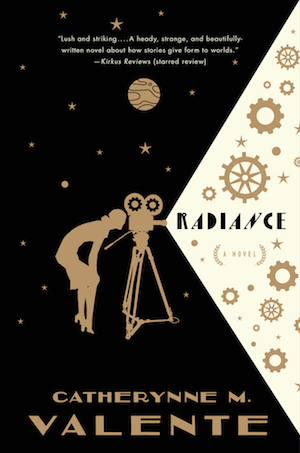
A different kind of alternate past on a celestial scale, Valente’s ambitious (and triumphant) novel sends humanity to outer space as early as 1858, astride the beautiful rockets of classic science fiction. Back on Earth, filmmakers like Percival Unck master the constraints of black-and-white silent films—the Edison family hoarding the patents for sound and color—while occasionally jaunting to Hollywood… on the Moon. Percival’s daughter Severin, in the typical contrarian nature of children, ventures out into the universe as a documentarian, poking into the mysteries of abandoned or destroyed colonies—until her own tragic disappearance on Venus in 1944.
Even with the various cultural touchstones, it’s a lot of worldbuilding to take in, but Valente deftly invites the audience into this SF tale by means of transmedia metafiction: Severin’s life (and death) story is told through screenplay excerpts, personal reels, interview transcripts, the entertaining space opera radio serial How Many Miles to Babylon?, and, of course, the gossip pages. These pieces of “found footage” fill in the edges of the world, sometimes overlapping, often contradicting, to create an incomplete but fascinating portrait of Severin’s artistic impact on a fantastic world.
Buy the Book


Radiance
Charlie the Choo-Choo — The Dark Tower by Stephen King
Young Jake Chambers picks up a copy of Charlie the Choo-Choo, an eerie take on Thomas the Tank Engine, early on in the course of The Waste Lands, the third book in King’s Dark Tower series. The children’s picture book centers on Engineer Bob and Charlie, a seemingly friendly train with a smile that “couldn’t be trusted.” On his quest with Roland, Jake begins to notice things from the book echoed in the real world—he nearly faints when he recognizes the real Charlie at a park in Topeka.
In our world, King actually wrote a version of Charlie the Choo-Choo under the name Beryl Evans, accompanied by increasingly unsettling illustrations for maximum creepiness.
Don’t ask me silly questions, I won’t play silly games.
I’m just a simple choo-choo train, and I’ll always be the same.
I only want to race along, beneath the bright blue sky,
And be a happy choo-choo train, until the day I die.
Buy the Book


The Waste Lands
Tales from the Hinterland — The Hazel Wood by Melissa Albert
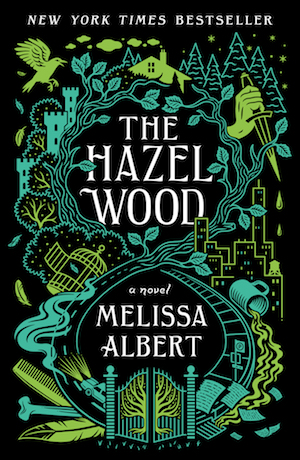
At seventeen, Alice is used to running with her mother away from many things, primarily the odd bad luck that follows them no matter where they temporarily settle, and her grandmother’s literary legacy. Althea Proserpine, profiled in Vanity Fair and worshipped via dog-eared copies of Tales from the Hinterland, is known for spinning darkly compelling fairy tales and inspiring fans who can get a tad too enthusiastic when they discover that Alice is the daughter of Ella, is the daughter of Althea. But when Althea dies at her remote estate, the Hazel Wood, and Ella is snatched away by a mysterious force, Alice must confront the possibility that the Hinterland is not just a story. Or rather, it’s a story, but it’s so much more for Alice and Ellery Finch, a Hinterland superfan, to unravel.
Part of the problem is, Alice doesn’t know her Hinterland all that well, due to Ella snatching her mother’s book away with protests that the stories aren’t for children. So when Alice realizes that her answers might belong in those dozen stories—whose creatures have already begun to leave their pages for the real world—she needs Ellery to tell her them, starting with her namesake “Alice-Three-Times”: When Alice was born, her eyes were black from end to end, and the midwife didn’t stay long enough to wash her. The novel is littered with retellings like this (the paperback edition has two extra), drawing the reader into the Hinterland in the same fashion as Alice and setting the scene for her eventual tumble through the proverbial looking-glass.
And soon, you too will be able to creep yourself out reading the Tales from the Hinterland: Albert is working on an actual collection fleshing out all of the stories mentioned in The Hazel Wood.
Buy the Book


The Hazel Wood
Fantastic Beasts and Where to Find Them — Harry Potter by J.K. Rowling
Over a decade ago, the most extra bit of worldbuilding in a Harry Potter book was when Rowling actually created seven real-life editions of The Tales of Beedle the Bard, the book of wizarding fairytales bequeathed to Hermione Granger. Handwritten and -illustrated by Rowling herself, each version embossed with a different semiprecious gemstone in order to differentiate them, these small treasures were given as gifts to people whose work was integral to the book series (like Scholastic editor Arthur A. Levine). Each contained not only “The Tale of the Three Brothers,” which forms the narrative backbone of Harry Potter and the Deathly Hallows, but also a number of other stories that Rowling fleshed out. And while in 2007 there were only the seven special editions, within a year public editions (standard and collector’s) were published for fans eager to read more wizarding folklore.
But even that was nothing compared to Newt Scamander.
Can you believe there was ever a time—way back in 2001—when Fantastic Beasts and Where to Find Them was nothing but an amusing, slim tie-in novel that Rowling wrote to let fans in on a glimpse of Harry’s Hogwarts experience? The 128-page volume was meant to look like Harry’s actual textbook, down to signs of wear and tear plus doodles and notes from the beloved trio themselves, clearly not paying any attention to Care of Magical Creatures. But since 2016, Newt Scamander’s humble textbook has spawned a five-movie mini-franchise of its own. That is worldbuilding at its finest.
Buy the Book


Harry Potter: The Complete Collection
What are your favorite hyper-worldbuilding details?
Natalie Zutter can only hope she manages to be this extra when she someday launches the Patreon for her post-apocalyptic audio drama. Talk above-and-beyond worldbuilding with her on Twitter!










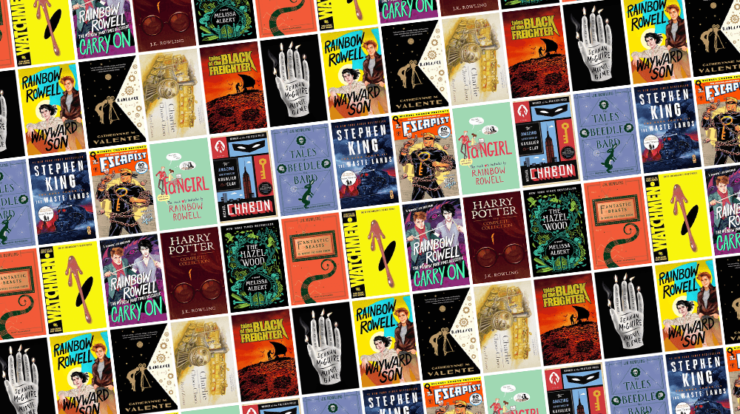


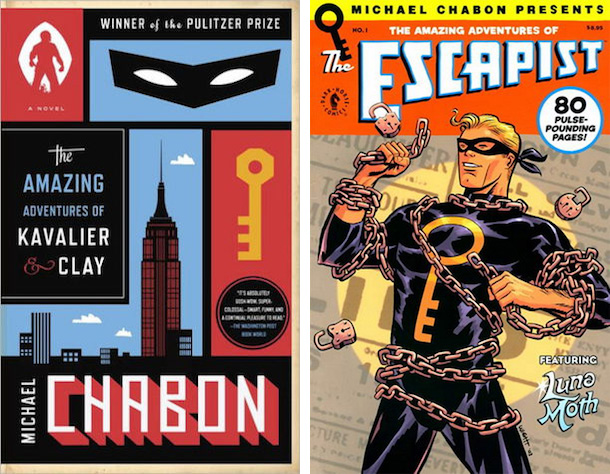
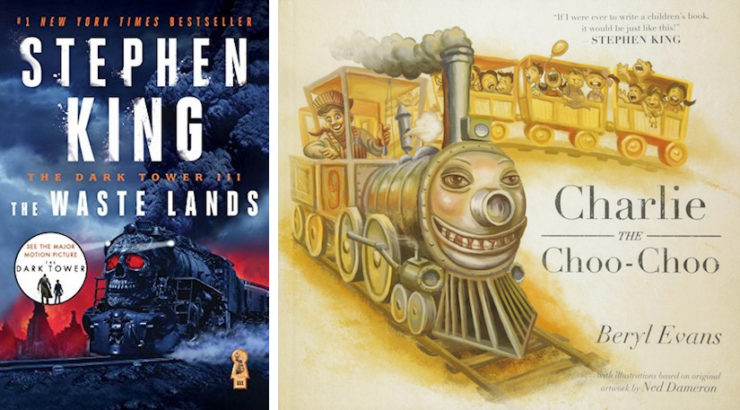

What a wonderful article! How about adding Brass Orchids?
An article about worldbuilding…with no Brandon Sanderson books? What is this madness?
In any case, all of these seem very interesting. I’ll have to check some of them out.
Would Fillory in The Magicians count? I’ve only seen the show, so I don’t know how far the books go in portraying the novels within the story.
My very first, never-sold spec novel way back when was an attempt at this kind of thing. It was called On Location, and was about a filmmaker tagging along with a Mars colony expedition to shoot the first-ever science fiction movie made on location in space. Since I’ve always been frustrated by how badly fiction misrepresents the filmmaking process, I took care to write the entire script of the movie within the book, then come up with a shooting schedule for the film based on that script, then plot the novel based on that shooting schedule. The book never quite worked out, though, and ended up just sitting in my (figurative) drawer. Some years later, I tried re-reading it, and while the novel itself was still somewhat entertaining (though with some embarrassingly self-indulgent bits), I realized that the screenplay was pretty awful. Perhaps because I wrote it more as a means to an end than an end in itself.
@3 That sounds fascinating!
I will have to check some of these out.
Years ago Dorothy Gilman wrote a mystery about a young woman looking into the death of the author of her favorite book, The Maze in the Heart of the Castle, in The Tightrope Walker. Four years later she released The Maze in the Heart of the Castle.
Another favorite is Robin McKinley’s Sunshine. I feel I should be able to go to the library and pick up Rae’s favorite comfort read Immortal Death and I’m so disappointed that I can’t. I’ve always felt the best fictional worlds are the ones that exist even when I’m not there to visit them. Those are the worlds where I’m sure there will be something new (books, music, movies) when I go back to visit again.
“An article about worldbuilding…with no Brandon Sanderson books?”
The article seems to be about meta-worldbuilding, worldbuilding via stories embedded within the fiction. Does Sanderson do story-within-a-story like Tales of the Black Freighter?
Chabon’s imaginary comic world was brilliant; it feels almost as tangible to me as some of the comic book universes I encountered in real life.
@6
Yup, lots of different myths and stories he weaves into them.
Hoid’s stories for one in the Stormlight Archive and the newspaper clippings from the Wax and Wayne Cycle (Mistborn Era 2) for another.
You can add a second pairing from Catherynne Valente.
Her very-much-for-adults novel Palimpsest mentions the childhood favorite book of one of the characters, The Girl Who Circumnavigated Fairyland in a Ship of Own Making, and having mentioned and described it, she found she had to write it. Once she did (crowdfunding it initially) it was wonderful enough that she ended up writing 4 more in the series.
How do you do this article, and never mention either Fillory or The Red Book Of Westmarch?
The book ‘Intervention’ by Julian May (psi powers, aliens), features a transcript of a 60 Minutes interview with a telepath at his uncles sci-fi bookstore.
A honourable mention to ‘The Forgotten Garden’ by Kate Morton, about a woman who gets caught up in a century-old mystery in Cornwall about a writer of dark Victorian fairy tales. Some of the bittersweet tales are scattered through the book, which made reading the book that more intense.
Where’s my cow?
And where are all the other books that Terry Pratchett created as tie-ins to his Discworld novels? There are a few companions etc. that are mentioned in the novels and then came out “for real”.
Honestly, there’s clearly some meta-goal (appropriately) that the author of this post has with respect to what they mean by hyper-worldbuilding. The intro is more than a little misleading in that it suggests this is going to be a list of extremely well-developed worlds. Yet here we find no mentions of the titans of Fantasy or Sci-fi who build vast worlds over titanic canons. Instead we see (hopefully) talented briefer pieces (where in the SFF context briefer may well mean a trilogy) with punchy meta-worldbuilding.
Personally, I wouldn’t have posted it with this title or intro.
@10 sue
Well, the title is “8 instances of sff-hyper-worldbuilding”, not “all instances of sff-hyper-worldbuilding”…
The “Coeur” (the “Realm of the Heart”) described in the autobiography of Michael Ashman, a text-within-a-text in M. John Harrison’s “The Course of the Heart.” The “autobiography” is forged, and its author invented, by a character within the novel, but the fantasy realm described in it may (?) be real after all… And further! The Coeur shares details of worldbuilding with the world of Viriconium from Harrison’s series of the same name, making perhaps that world continuous with the *fictional* world inside the world of “The Course of the Heart,” and helping to build a very strange Harrison-verse.
(And yes, it is ironic this is the same Harrison who wrote that screed against worldbuilding!)
Don’t forget Titus Groan and Gormenghast! The third book, Titus Alone, ventures beyond the claustrophobic world of the palace and doesn’t really fit into the Ghast-verse.
@15/Andrei: In that On Location spec novel I wrote long ago (see comment #3), two of the previous movies that the director had made were based on other unsold fiction concepts of mine that I hoped I’d also write and publish; the intended conceit was that those other fictional universes would be established as fiction within my primary SF universe, so they’d all ultimately be part of the same overarching continuity, in a way. These days, though, I’ve never really been tempted to do that with my extant or planned fictional universes. The idea of only one of my universes being “real” doesn’t appeal to me anymore. (Plus I only have two ongoing original universes in print at this time, plus a couple of standalone stories, so the opportunity hasn’t really been there.)
How about the great original, Tolkien? The Silmarillion and other later works (as in, published posthumously from his notes) are drawn from the “backstory” tales, myths and legends of Middle Earth that he first invented as thrown in bits of world -building in the Lord of the Rings.
For that matter, although not quite in the same league, one thing I have always enjoyed about David Weber’s Honor Harrington series (and to a lesser but similar extent, his and John Ringo’s Empire of Man series about Prince Roger) is the way chapters and sections will start with quotes from later learned academics analysing the history of that time.
World-building – and NO ONE listed S. M. Stirling’s Novels of the Change (both series)???? For shame!
Ian m banks.
Alistair Reynolds.
Steven Erikson.
Glen Cook.
William Gibson.
Michael Moorcock.
Philip Kerr.
Dan Abnett.
Frank Hebert.
Elizabeth Bear
Alliette de bodard.
Gwyneth Jones.
Eleanor Arnason
Tanith Lee.
Ann McCaffrey.
Caitlin R Kiernan.
Michael Swanwick.
Chritelle David.
Jeff Vandermeer Shriek:an afterword.
A sister’s biography of her brother presumed dead sister dies brother returns not dead and reads his own biography making his own comments observations.
Ambergris belongs here for sure as Colin pointed out above
Suzanna Clarke’s Jonathan Strange and Mr. Norrell deserves special mention here. The author was at pains to introduce a frightening amount of detail of the alternate reality she had constructed. From references to in-verse books, to detailed asides on historical characters, the novel conjured up a vivid and lived-in reality.
Frank Herbert’s epigraphs opening each chapter of Dune are a fine example, as are the various “articles” attached to the end.
To be really pedantic; Fantastic Beasts and Where to Find Them was not a novel. It’s a textbook of imaginary creatures which lacks the structure of a novel.
I know, I know everyone’s a critic. It’s just one of those things that bugs me.
This is a great list, and obviously can’t include everything. Since these things are created to inspire discussion, I would like to mention China Miéville’s Perdido Street Station. That world, and its inhabitants, was so well-described, it felt like a real place, one I’ve never forgotten.
Charles Stross is one of those rare authors who can’t help but worldbuild with every paragraph.
I love this kind of books! I’m glad to see people adding their own so I’ll add one too: The Language of Thorns by Leigh Bardugo is a (really pretty) book of folk stories from within the Grishaverse, where other series written by the author occur.
@damien:
Actually, yeah, he does. “Way of Kings” is named after a fictional in-world book that’s excerpted. The broadsheets in Mistborn Era 2 have tons of stories advertisements and are really well done. The “Ars Arcanum” is excerpted as basically the glossary of every book and is written by an in-cosmere character so it contains things like errors and mistakes that are later corrected (or we just know to be wrong for other reasons).
And of course the world-building above includes more than specific in-story stuff like maps and iconographies for chapter headings which Brandon also does an amazing job.
There are a TON of examples of why Brandon’s world-building is truly world-class.